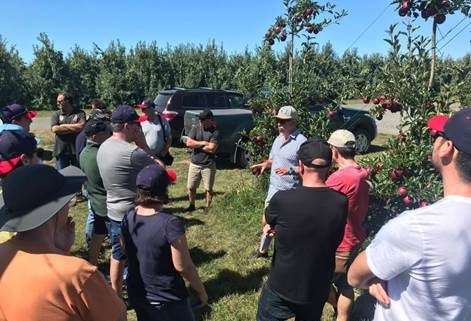Poma de Girona producers are trained in New Zealand
The producers of the PGI Poma de Girona visited, between February 23 and 29, Hawke’s Bay, in the northeast of New Zealand, to learn about new techniques and new systems of apple production. The expedition consisted of 19 members -among producers, technicians and managers- of the three companies that produce and market the Protected Geographical Indication (PGI) Poma de Girona (Girona Fruits, de Bordils, Giropoma Costa Brava, de Ullà, and Frutícola Empordà , from Sant Pere Pescador).
Llorenç Frigola, president of Poma de Girona, explains that “every year we organize technical trips and this time we have chosen New Zealand because it is the cathedral of fruit growing, it is the most favorable place in the world and where there is more production per hectare, which can reach up to 150 tons ». One of the other reasons that led Girona growers to choose this destination is because with some of these New Zealand producers they are part of the hot weather hybridization program Hot Climate Breeding Program (HCBP). It is a project for the production of apples in hot climates. The HCBP program aims to improve apple flavor, texture, color and adaptation to climate change, and one of the results is “the transfer for 15 years of a technique by which, now in Girona, we started to have the first viable varieties to produce in the hot weather ».
For the president of Poma de Girona, New Zealand has a “very good soil condition, with a lot of organic, fertile matter and a very benign climate. There are practically no hailstorms or frosts and the winters are not cold, this allows the apple tree to have a very long development with a very short winter period with very good conditions. His apple is very strong and has a lot of color so that the ultraviolet rays are high ». According to Frigola, «it is clear that each area is different, but there are always actions to put into practice and techniques to experiment in our home. There, they produce a very red, thick and sweet apple that they export to Southeast Asia; Twenty years ago they had smaller, more acidic apples that they sent to the European market but now, this one is self-sufficient ».
The annual technical visit took place in northeastern New Zealand
Another difference Frigola sees is in the market: “It is different because we store and serve apples for 12 months at supermarkets while they produce and make them during the six months they work each year.” Apple-producing companies in New Zealand have a very important part of their production in exclusive club-type varieties that only they can produce, “they buy the production rights of these varieties. This trend also begins to be important among the companies of Poma de Girona. The apples are the same, but in New Zealand the characteristics are different by color, hardness and sweetness ».
Girona producers have visited confection plants and plantations in New Zealand after having known, in recent years, new techniques in Poland and on the west coast of the United States.








